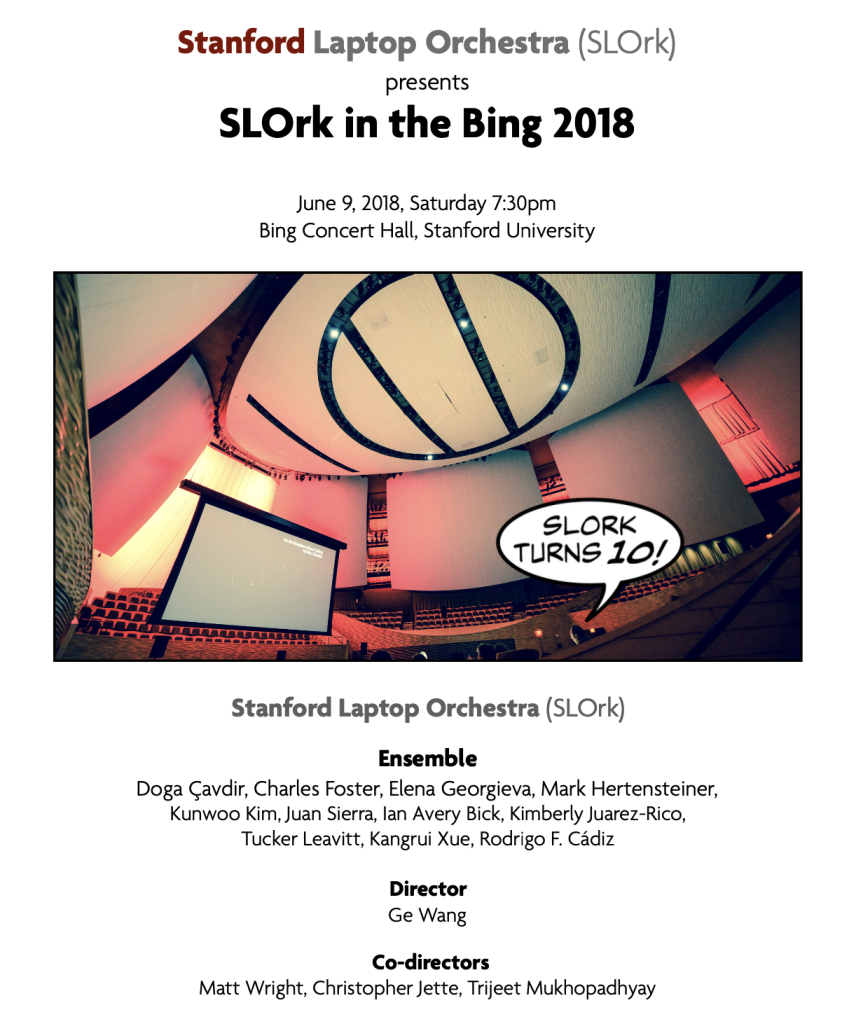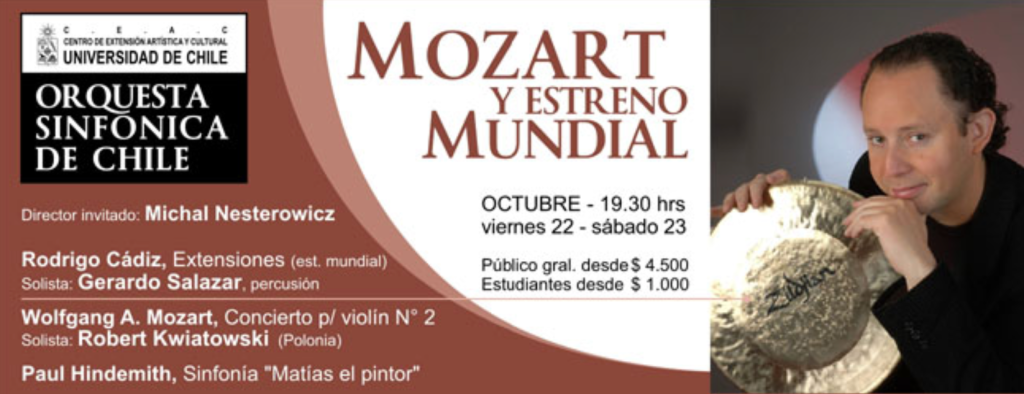Representative Works
I have chosen the following three works as representative of my music. Due to the format presentation, stereo and over the internet, I have not chosen any of my multi-channel acousmatic works, because they were created always with a multi-channel presentation format in mind. It is difficult to select only three works from a corpus of almost seventy compositions. Thus, I have selected works that show a variety of some of the different approaches I have taken in relation to computer music composition and that can show different aspects of my compositional thinking and abilities.
These three works showcase different approaches to electronic/computer music composition. Iterum Vivere is a composition for early-music ensemble and electronics in non-real time, usually called tape or fixed media. The tape material was made entirely out of different sound processing algorithms of the ensemble’s previous recording of an old Baroque piece by Couperin. Orbitae is a composition for arcontinuo, a novel electronic musical instrument of my own making and laptop orchestra, where everything works in real-time. The laptop orchestra follows a visual score that appears on their laptop’s screens. Extensiones is a composition for percussion soloist, symphonic orchestra, and live electronics. The soloist plays vibraphone, triangle, and an iPad and wears an arm movement sensor that controls how the real-time electronics react to his performance. To my knowledge, this was the first time (back in 2010) that an iPad was given such a principal role in an orchestral setting.
Please click on the triangle to the left of each work’s title to access program notes, scores when available, video recordings, and performance information of each work.
Iterum Vivere (2022), for early music ensemble and electronics.
Iterum Vivere is a work dedicated to the UC’s Early Music Study (Estudio MusicAntigua, EMA). The title, coming from Latin, can be translated as revive or live again. The idea of the piece is to give new life to the work “Concert instrumental sous le titre d`Apotheose de Monsieur de Lully” by François Couperin, a series of three trio sonatas dedicated to Jean-Baptiste Lully, first published in 1725. Similar to L’Apothéose de Corelli, this composition serves as a prime illustration of programmatic music. The overture incorporates elements of Lully’s French overture style, juxtaposed with segments that bear the distinctive traits of Corelli’s trio sonatas.
My aim was to “revive” this work through a procedure that preserves intact the entire rhythmic structure of the work, while completely altering the pitches and harmonies. Thus, the original work is “revived” in a contemporary format, also accompanied by computer music composed by the sonic transformation of each one of the movements of the original work, previously recorded by EMA.
Iterum Vivere was made possible thanks to a Creación y Cultura Artística (CCA) grant from Dirección de Artes y Cultura, Vicerrectoría de Investigación, Pontificia Universidad Católica de Chile.
Score, audios, and materials: https://www.dropbox.com/sh/dzkgei4bowqmdkc/AAApRaJF6jh4wtJw3kalMndHa?dl=0
Movements of the work
00:00 I Modérément
02:40 II Vivement
04:28 III Très vite
05:35 IV Noblement
07:36 V Vite
08:36 VI Plainte
12:23 VII Très légèrement
13:46 VIII Largo
16:48 IX Majestueusement
In the following video, artificial-intelligence-generated animations provide a visual counterpart to the music of each of the nine movements of the piece.
The following live performance presents the original Couperin’s work alternated with Iterum Vivere, movement by movement.
Performance:
Estudio MusicAntigua UC
Sergio Candia – Recorder and conducting
Juan Fundas – Baroque oboe
Gonzalo Beltrán – Baroque violin
Gina Allende – Soprano Viola da gamba
Florencia Bardavid – Bass Viola da gamba
Eduardo Figueroa – Archlute
Camilo Brandi – Harpsichord
Rodrigo F. Cádiz – Electronics
https://www.beethovenfm.cl/evento/estudio-musicantigua-uc-rodrigo-cadiz-vs-francois-couperin
Orbitae (2018) for arcontinuo and laptop orchestra.
Orbitae is a word in Latin that means orbits. This is a piece in a “concerto” style, with the arcontinuo playing the role of a soloist while the laptop orchestra counterpoints the material the soloist proposes and transforms. The soloist explores different sound worlds that he then passes on to the orchestra. As the performance advances, sometimes the focus is on only one sound while in others the control is done over a group of them. As time progresses, each performer of the orchestra explores different zones of a two-dimensional sound orbit, in a sinusoidal matter. This piece explores the spaces between orbital/sinusoidal motion, score-following/improvisation, and soloist/ensemble.
The composition of Orbitae was made possible thanks to the support of Programa IBERMÚSICAS and Consejo Nacional de la Cultura y las Artes, Government of Chile.
Performance:
Rodrigo F. Cádiz – Arcontinuo
Stanford Laptop Orchestra (SLOrk)
Bing Concert Hall, Stanford University

https://slork.stanford.edu/events/notes/2018-slork-spring.pdf
Extensiones (2010), for solo percussion (vibraphone, iPad, triangle), orchestra, and live electronics.
Extensiones is a work for solo percussion, orchestra, and live electronics, composed especially for Gerardo Salazar and the Chilean Symphony Orchestra. The sound material of the work is derived from a compositional principle called infinite series, originally proposed by the Danish composer Per Nørgård in 1959. This material is presented in different forms and takes on different manifestations as the music progresses, both in acoustic and electronic form. In Extensiones, the role of digital technology does not constitute a mere accompaniment to the symphonic material, but rather interacts with it at various levels, directly modifying the sound result produced by the orchestra. Unlike the traditional format for orchestra and electronics where it is presented on a fixed support, in the case of this work the electronics are “alive”, in the sense that the computer reacts in real-time to the performance of the soloist and the orchestra, and becomes another performer in the ensemble. The computer knows and follows the score just like any musician in the orchestra, which allows it to instantly generate sonic responses and reactions to what is happening. Extensiones also explores, through technology, the gestures of the soloist, since in addition to the musical performance of acoustic instruments, specialized sensors capture information from the performer’s gestures, which is used in the generation and manipulation of the musical material. This same search was previously carried out in the work Tensiones, for virtual percussion, ensemble, and live electronics, composed in 2008 for Gerardo Salazar himself and the Taller de Música Contemporánea UC. In this sense, Extensiones “extends” some of the ideas and approaches contained in Tensiones, hence its title. The composition of Extensiones has been possible thanks to the support of the National Music Promotion Fund (Fondo de Fomento de la Música Nacional) and the National Council of Culture and the Arts (Consejo Nacional de la Cultura y las Artes), of the Government of Chile.
Score and audios:
https://www.dropbox.com/sh/gpevek1g9j136sr/AACIPN8CnlL2b9gPXe89-1CYa?dl=0
Movements
0:00 Majestic
4:20 Vibrant and virtuoso
8:33 Slow, cadential
12:20 Delicate
15:08 Precise
16:17 Dark but energetic
18:17 Light and vibrant
Performance:
Gerardo Salazar, vibraphone, iPad, triangle
Rodrigo F. Cádiz, live electronics
Michal Nesterowicz, conductor
National Symphony Orchestra of Chile
Teatro Universidad de Chile, Santiago, Chile

https://uchile.cl/noticias/66512/la-sinfonica-y-gerardo-salazar-estrenan-innovadora-obra-
https://www.babelscores.com/es/catalogs/instrumental/extensiones
https://purochilemusical.blogspot.com/2010/10/la-orquesta-sinfonica-de-chile-se-pone.html